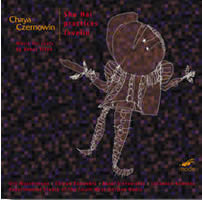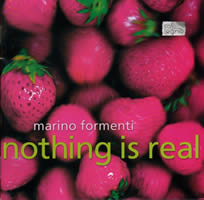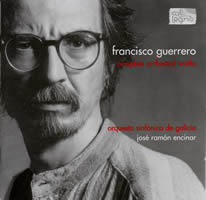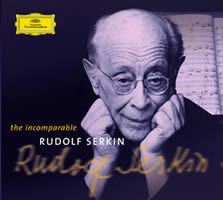Heavy Rotation in 2003: Czernowin, Formenti, Guerrero, Harada, Harrison, Serkin, Pollini
|
Grant Chu Covell [December 2003.] Possibly, a more truthful title: “Best of 2003 Based on an Arbitrary and Random Selection Assembled by Someone with Predictable Tastes.” Here are a few of this year’s arrivals that demand repeat listening, “heavy rotation” in radio-airplay parlance. Most reflect my meat-and-potatoes interests. Serkin and Pollini playing Beethoven are necessary for the soul. Were you naïve enough to visit and let me spin some discs, you’d have to listen to Harada’s Bone #, Czernowin’s Six miniatures, anything from Harrison’s Metier disc, Guerrero’s Antar Atman, and Lucier’s Nothing is Real. Serkin’s Op. 111 or Pollini’s Op. 57 would be a chaser. If you had time for just one track, it’d be Harrison’s The Fourteenth Terrace.
“Shu Hai Practices Javelin.” Chaya CZERNOWIN: Six miniatures and a simultaneous song (1998); Shu Hai in an orchestral setting (2000-01); Shu Hai mitamen behatalat kidon (1996-97). Elision Ensemble; Ute Wassermann (voice); Basel Sinfonietta, Johnannes Kalitzke (cond.); Experimental Studio of Heinrich Strobel Stiftung WDR, André Richard (live electronics). mode 117 (http://www.mode.com/). I don’t know what Czernowin’s music is about. Fascinating and joyously impenetrable, her compositions will leave you spellbound. Play ’em loudly, you’ll be stunned. These three pieces are so involved that listening to them repeatedly is like hearing a different work each time. Czernowin’s music can be self-referential. Whole chunks of one composition may be transformed into another. The Six miniatures are a trio and quartet played concurrently. Cage and Carter have employed similar but less intricate effects. The trio is soprano (Deborah Kayser), viola (Erkki Veltheimalto) and guitar (Geoffrey Morris). This delicate ensemble heroically attempts to underscore a single line of text: “I believe that beyond these bushes I could bathe in warm cisterns.” The quartet of bass flute (Paula Rae), bass clarinet (Brian Catchlove), alto sax (Timothy O’Dwyer) and cello (John Tooby) is rudely inconsiderate. Slithering microtones, coarse glissandi, and truckloads of extended technique create a continuously disconcerting landscape. The Shu Hai pieces make Six miniatures look conventional. Both require a live voice, nine tape recordings of the voice, and real-time electronics. Shu Hai in an orchestral setting adds an orchestra to elaborate upon Shu Hai mitamen behatalat kidon’s second movement. Ute Wassermann is the vocal soloist. She generates all nature of sounds: writhing, sputtering, groaning, hissing, rasping, you name it. The underlying text is unintelligible. Meticulous mode provides it anyway so you can sample its elemental pungency. Czernowin leans heavily upon Wassermann’s abilities to fashion “distilled, non-linear poetry.” However, this composer’s orchestral handling proves she’s in control, with nothing left to chance. The widest range of nonstandard instrument noises inhabits her palette. Yes, like Lachenmann. Similar sounds (plucking, tapping, col legno, etc.) appear together, creating clouds of texture. Shu Hai in an orchestral setting is especially riveting because you never know which corner of the orchestra may erupt next or how the voice will be transformed. The performers must love this music. The Elision Ensemble in Six miniatures is crystal-clear and exquisite. Conductor Johannes Kalitzke and the Basel Sinfonietta bring it all together superbly. Of course, anything coming from the WDR’s Heinrich Strobel Experimental Studio is worth a listen, especially if shepherded by André Richard. This is mode’s second Czernowin disc. The first, mode 77, received La Folia acclaim here. May there be a third, and a fourth, and so on. (maim zarim, maim gnuvim is on a three-disc set from Donaueschinger Musiktage 2002, col legno 20229.)
“Nothing Is Real.” Beat FURRER: Voicelessness – the snow has no voice (1986); John CAGE: Music Walk (1958); One (1987); Salvatore SCIARRINO: Perduto in una città d’acque (1991); Notturno Crudele N. 2: Furia, Metallo (1999); Roman HAUBENSTOCK-RAMATI: Pour Piano (1973); Alvin LUCIER: Music for Piano with Amplified Sonorous Vessels (1990); Nothing is Real (Strawberry Fields Forever) (1991); Georg Friedrich HAAS: Hommage à Ligeti for two pianos with a quarter-tone difference (1985). Marino Formenti (piano). col legno WWE 1CD 20223 (http://www.col-legno.de/). Distributed in the US by Qualiton (http://www.qualiton.com/). All musicians make decisions. Some are benign, having little effect on the music’s performance. Sometimes the composer asks the performer to make significant choices. The results owe much, if not everything, to the player’s intelligence and judgment. Completely trust pianist Marino Formenti. You should follow him into a burning building if he were to play there. He’s fashioned a marvelous recital disc that explores a wide range of contemporary piano works. Alvin Lucier is one of three composers represented twice. The disc takes its title from his Nothing is Real (Strawberry Fields Forever). Deceptively simple and eerily beautiful, phrases from the Beatles song appear in different octaves only to be replayed from inside a teapot. Sounds ludicrous, right? Lucier’s no slouch: The music enchants. Later on, Music for Piano with Amplified Sonorous Vessels feeds the piano’s sound through large pots altering its resonance. Into one of the two Cage pieces, Music Walk, Formenti introduces the original Beatles tune alongside the required radio and random piano noise. Coming nearly 30 years later, One is a late “number piece” whose fixed pitches are to be played within a variable time range. One’s coolness matches Furrer’s sheer Voicelessness and Sciarrino’s Perduto in una città d’acque, a delicate contemplation upon visiting the dying Luigi Nono in Venice. Sciarrino’s other work, Notturno Crudele N. 2, subtitled “rage, metal,” is at the opposite pole. Formenti dispatches the Italian’s violent and calisthenic work easily, relishing the similar chaos and extended technique required for Haubenstock-Ramati’s Pour Piano (booklet pictures show Formenti sawing wood). The most deadening composition is Haas’ Hommage à Ligeti requiring two pianos tuned a quarter-tone apart to be placed at right angles. The pianist hammers away unremittingly at both. Ligeti’s early keyboard works, e.g., Continuum and not the later Etudes, were probably Haas’ inspiration. There’s something here for everybody, even in the cover art’s surreal pink strawberries. Formenti has devoted a disc to Lachenmann’s piano music (col legno WWE 1CD 20222), which will get its day here sometime soon. Should you be in New York in April 2004, he gives three concerts at Lincoln Center. One program is devoted to Lachenmann, another presents works from this CD.
“Complete Orchestral Works.” Francisco GUERRERO: Coma Berenices (1996); Ariadna (1984); Sáhara (1991); Oleada (1993); Antar Atman (1980). Orquesta Sinfónica de Galicia, José Ramón Encinar (cond.). col legno WWE 20044 1CD (http://www.col-legno.de/). Distributed in the US by Qualiton (http://www.qualiton.com/). Complex forms in nature and mathematics inspired Guerrero to write unforgivingly arid music. Ligeti’s early orchestral scores were also a major influence. A comparison with Xenakis is inevitable, though I find the Iberian to be more sinister; the Greek exile wrote more humanely. Nonetheless, Guerrero’s symphonic pages rank among the 20th century’s most forceful music. Ariadna is a knotty mass for 20 stringed instruments (ten violins, five each violas and cellos). Rapid alternations between pizzicato, col legno, massed trills and slurpy glissandos fill this barbaric landscape derived from combinatorial analysis. Oleada is for a 50-player string orchestra. Individual voices are lost to ribbons of sound which slowly fluctuate in dynamics and pitch. These energized sounds conjure up visual or tangible components. A touch of Scelsi opens Sáhara. Obsessing over a single pitch, the strings deliver the first volley in this volcanic orchestral work. Brass and winds join in later to complete the cauterization. Antar Atman, this collection’s oldest, owes much to the massed orchestral textures of Ligeti’s Atmospheres. The most traditional canvas in Guerrero’s output grows to a deafening roar. Guerrero died in 1997 at 47, with Coma Berenices a decisive summation of his vocabulary and technique. He had planned on working in a new direction after it. Sadly, that turn is lost to us. Orchestrating countryman Albéniz’s Iberia was among his last projects. He completed only six movements. The Orquesta Sinfónica de Galicia does well with these intimidating pieces. (A more conventional disc devoted to Villa-Lobos, Auvidis Valois V4843, offers fewer challenges.) Auditioning all five orchestral pieces at a single sitting is exhausting. Guerrero’s Zayin, a granitic seven-part series variously combining two violins, viola and cello, is significantly less demanding (with the Arditti Quartet on Almaviva DS-0127).
“After the Winter.” Keiko HARADA: Heavy Wood (1998); Labyrinth VIII (1996); Sonora Distancia II (1996-97); Bone + (1999); Bone # (2000); Bone (1997); Abyss (1992-95). Ictus. Cyprès CYP5605 (http://www.cypres-records.com/). I listened to this daily over a several-month stretch. The musicians of Ictus perfectly realize Harada’s mesmerizing and ingenious compositions, some for soloists, some for ensemble. Bone # thrills on every audition. Harada has crafted a masterpiece. Scored for violin (George Van Dam), kalimba (Kuniko Kato) and live electronics, the sinewy violin is the perfect foil for the buzzy sound of the gently amplified African thumb piano whose twangy low notes are so enticing. Harada’s music surpasses geographical and traditional associations. Ictus cellist François Deppe’s notes describe the composer’s intentions: “ Harada’s quest is how to write nomadic music, music that escapes cultural traditions, whose identity cannot be pinned down.” Labyrinth VIII, for cello (Deppe) and piano (Jean-Luc Fafchamps) is scored for the most traditional ensemble. However, this isn’t a garden-variety cello sonata. A deliberate intensity combined with expressive microtones puts this alongside B.A. Zimmermann’s Intercomunicazione. Despite her goal of “eluding geographical as well as historical ties,” Harada is neither brutish nor simplistic. Studies with Ferneyhough have honed Harada’s intellectual integrity. I also sense an affinity with Lachenmann in the need to discover new territory. Harada’s writing is neither dry nor pasty. There’s a vein of self-deprecating humor. Heavy Wood, for violin (Igor Semenoff), guitar (Tom Pauwels), bass clarinet (Dirk Descheemaeker), double bass (Géry Cambier) and piano (Fafchamps), opens with a jazzy riff embellished by indefinable scratches and spoken syllables. The piano stays in the background while the others busy themselves with fascinating material. Heavy Wood is assertively hip even when pretending to stumble over a tango-like flourish. Other works include solos for accordion, Bone +, and piano, Bone. Bone + relates the accordion to the shô, the Japanese mouth organ. The three similarly titled works share an episodic structure. Sonora Distancia II is a concerto for guitar and 11 instruments. Abyss completely redefines the interactions of clarinet, violin and cello trio. Georges-Élie Octors conducts Heavy Wood and Sonora Distancia II. I can’t get enough of this music. Snag this and be on the lookout for more Harada. (Stefan Hussong’s recital disc on Thorofon [CTH 2449] presents Bone + alongside pieces by Hölszky, Berio, Nordheim, Lim — Hyunkyung, not Liza — and Gubaïdulina. Even though the work, Harada’s fifth to feature accordion, was commissioned for Hussong, it’s an unenlightening program.)
“The Light Garden Trilogy.” Sadie HARRISON: The Light Garden (2001); The Fourteenth Terrace (2002); Bavad Khair Baqi! (2002); with traditional Afghani music. The Tate Ensemble; Lontano, Andrew Sparling (clar.), Odaline de la Martinez (cond.); Peter Sheppard Skaerved (violin); Ensemble Bakhtar: John Baily (rubâb), Matthaios Tsahourides (Pontic lyra), Veronica Doubleday (voice, harmonium), Ustad Asif Mahmoud (tabla). Metier MSV CD92084 (http://www.metierrecords.co.uk/). Heard from the next room it might be possible to confuse Sadie Harrison’s eloquently crafted compositions with the interleaved traditional Afghani music. Both styles are elegantly played and wonderfully recorded. Metier releases always sound excellent. David Lefeber has curated a catalog of consistently impressive discs. In such lofty company, this one still stands out. The four-person Ensemble Bakhtar gets things rolling with Naghma-ye kashâl Bairami, a traditional Afghani piece intended to be played at a concert’s start. The lute-like rubâb and violin-like Pontic lyra float iridescently over harmonium and tabla. Harrison’s The Light Garden, for clarinet, violin, viola, cello and piano, follows. Modeled on the Naghma-ye kashâl form (“bairami” in the preceding tune’s title signifies its mode), two contrasting styles engagingly occupy the quarter-hour. Distinctly non-European in its mode and with the occasional spoken Persian syllables, Harrison’s silvery The Light Garden forges something new and convincing from disparate cultures. The Tate Ensemble plays devotedly; this is a labor of love. Played by Pontic lyra and tabla, a traditional Herati lovesong, Bibi Gol Afruz (“Shining Flower Lady”), relaxes the pace before Harrison’s The Fourteenth Terrace for solo clarinet and ensemble. Here, too, Harrison has concocted something special. Through several contrasting sections, the clarinet’s liquid solos propel the supporting ensemble (two violins, viola, cello, bass, piano and percussion) into a frenzy which finally finds release in a well-earned eerie conclusion. No notes are out of place. Clarinetist Andrew Sparling plays magnificently. This piece, along with Harrison’s other two, was inspired by the gardens of Afghanistan’s 16th-century warrior-poet Zahiru’d-din Muhammad Babur. Veronica Doubleday sings the poignant lullaby Allâh Hu before solo violinist Peter Sheppard Skaerved concludes Harrison’s trilogy with the fiery Bavad Khair Baqi! Bakhtar’s musicians are British, Greek and Afghani. Doubleday is a British ethnomusicologist who trained in Herat and sings in Farsi with incredible passion and expression. A desperate piece, Bavad Khair Baqi! summarizes and resolves themes and images from the trilogy’s preceding parts. Skaerved plays intensely. The music ends much too soon. Ensemble Bahktar has the last word in luminescent Herati folksong Siah Chesm-e Khumari (“Your Captivating Black Eyes”), voice and instruments finally combining. Hit the repeat button on your CD player and let the whole disc spin two or three times. Metier has accomplished something quite remarkable with Harrison’s amazing music and the Bakhtar’s vibrant playing. Indisputably one of this year’s best. The disc also contains a wealth of multimedia material. There are musicians’ bios with photos taken during the recording sessions. Harrison also discusses the music’s background. Included are writings and links to material about the decimated Afghani music and the surrounding political issues.
“The Incomparable Rudolf Serkin.” Ludwig van BEETHOVEN: Piano Sonata No. 30 in E major, Op. 109 (1820); Piano Sonata No. 31 in A-flat major, Op. 110 (1821-22); Piano Sonata No. 32 in C minor, Op. 111 (1821-22); Johannes BRAHMS: Sonata for Piano and Violoncello in E minor, Op. 38 (1865); W.A. MOZART: Concerto for Piano and Orchestra No. 16 in D major, K. 451 (1784). Rudolf Serkin (piano); Mstislav Rostropovich (cello); Chamber Orchestra of Europe, Claudio Abbado (cond.). DG 474 328-2 (http://www.universalclassics.com/). Ludwig van BEETHOVEN: Piano Sonata No. 22 in F major, Op. 54 (1804); Piano Sonata No. 23 in F minor, Op. 57, “Appassionata,” (1804-5); Piano Sonata No. 24 in F-sharp major, Op. 78 (1809); Piano Sonata No. 27 in E minor, Op. 90 (1814). Maurizio Pollini (piano). DG 0000059-2 (http://www.universalclassics.com/). At his debut recital in 1846, a ten-year-old prodigy proposed a daring encore: Pick a number from one to 32, and he would play the corresponding Beethoven piano sonata from memory. A late sonata’s technically assured performance would probably have made quite an impression. Realistically, I wouldn’t want to hear a child play a late or even middle sonata, even if that child was Camille Saint-Saëns. However, here we have a 60-year-old Pollini delivering fire, and Serkin, in his 80s, with a lifetime’s experience at his disposal. Sure, Serkin is a tad shaky, but I’ll take what he has to say about Beethoven’s last three sonatas over anyone else’s interpretation. Serkin has had decades to mull over these masterpieces captured live in 1987. Beethoven in his last quartets and piano works sounds like someone thinking out loud, a man determined to get from one place to another but allowing meaningful detours, embellishments, and even a few musical jests. With Serkin at the keyboard, we have two great musical minds in empathy. Tempos ebb and flow uncannily; this isn’t square, metronomic playing but rather a magisterial discourse. Nowhere is this more evident than in Op. 110’s last two movements. Serkin’s gentle slowing and quickening unerringly delineate themes in the slow movement and fugue. I’m smitten by Opp. 109 and 111’s concluding variations, which have never before sounded so right and so heavenly. In the Op. 109 finale’s second variation, Serkin’s miraculous touch makes the gently leaping voices cavort like water sprites. The Brahms sonata and Mozart concerto, centerpieces in their own right, are encores here. Rostropovich and Serkin came together in 1983 for a ghostly-elegant performance of the E-minor sonata. The lighthearted D-major concerto was recorded live in 1997, the Chamber Orchestra of Europe buoyant under Abbado, who almost overwhelms the pianist’s left-hand figurations. Labels characteristically trot out hyperbole when reissuing legendary performances. There’s none of that here: “Incomparable” understates the case. Even with his formidable experience, Pollini is young compared to Serkin. The Op. 57 “Appassionata” greatly impresses: a thundering first movement, tenderness in the second’s variations and more dramatic storminess at the close. His technical prowess unleashes surprises into every coda, especially in the last movement where he cranks up the tempo, producing such immense force that the mind’s eye sees him jumping off the bench. Here too there’s an encore disc — live, feisty performances of Opp. 78 and 57 taped June 4, 2002, at Vienna’s Musikverein.
Beethoven, Brahms, Cage, Czernowin, Furrer, Guerrero, Haas, Harada, Harrison, Haubenstock-Ramati, Lucier, Mozart, Sciarrino
[More Grant Chu Covell]
[More
Beethoven, Brahms, Cage, Czernowin, Furrer, Guerrero, Haas, Harada, Harrison, Haubenstock-Ramati, Lucier, Mozart, Sciarrino]
[Previous Article:
Random Noise 4: Picking Nits and Winners]
[Next Article:
Random Noise 5: Successful Trespass]
|






